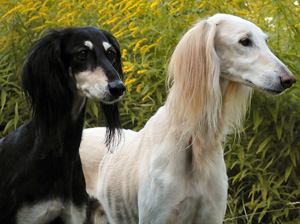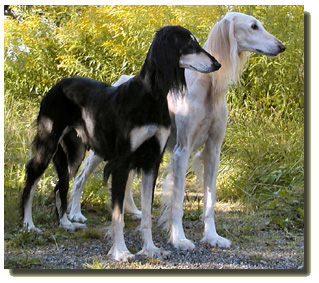
Saluki
Group: Hounds
Origin: Middle East
Height: 23 to 28 inches (58-71 cm)
Weight: 50 to 65 lbs
Also Known As: Gazelle Hound and Persian Greyhound

“Dina” Kirman Obadiah and “Sulo” Tazillah Sultan Al-Arab
(International champions)
Photo credit: ©Tazillah/Desierto Belleza Kennel
CLICK HERE to View Breeder Listings
Breed Profile
While the Saluki’s (also known as the Gazelle Hound and Persian Greyhound) origins are not well known, this is a versatile breed of Sighthound said to have a rich history. What is known is that the Saluki has been associated with the Middle East since antiquity and has always been used for hunting. It is known that the breed was held in great esteem, called “el hor” (the Noble) by the Arabs and was bred as carefully as the famous Arabian horses, with speed and endurance in mind. The breed is also said to have been a valued and honoured companion to Egyptian nobility and was known to be mummified like the Pharaohs.
The Saluki also held a very unique position within the lives of his Eastern and Nomad owners who were often Muslim: The Saluki was allowed to enter the tents of nomads and the courtyards of settled breeders whereas other dog breeds are considered “unclean” and cannot be touched. Even today, the Saluki continues to be valued and used for hunting in most regions of the Middle East where he originally worked.
The Saluki is an elegant, streamlined aristocrat. He is a reserved and very independent hunting hound, excellent long distance runner, intuitive and intelligent. Today, the Saluki is a graceful companion seen competing in the show ring as well as in lure and open field coursing. He also enjoys participating in agility, obedience, and tracking. With his generally calm, and dignified temperament, he is extremely devoted to his family and also makes an excellent watchdog.
The Saluki’s coat is smooth with a soft silky texture. There may be slight feathering on the legs, at the back of the thighs and he may also have slight woolly feathering on the thigh and shoulder. The Saluki comes in many colours — white, cream, fawn, golden, red, grizzle and tan, tricolour (white, black and tan), and black and tan.

Photo credit: ©Tazillah/Desierto Belleza Kennel
Health Issues
Anesthetics — Like all members of the Sighthound family, the Borzoi is sensitive to a number of anesthetics. It is very important to discuss this with your Veterinarian in advance of any required surgery. For additional information, see: Anesthesia And Your Saluki from the Saluki Club of America.
- Bloat — As with any deep-chested dog, the occurrence of Bloat or Gastric Torsion is a real possibility in the Borzoi. If you are not familiar with this condition, it is absolutely necessary to learn about it and know the symptoms — This is a real emergency and a life threatening condition that requires immediate Veterinary attention. See Gastric Dilatation Volvulus (GDV) – Bloat in the Health and Nutrition section of Canada’s Guide to Dogs for more information and First Aid for Bloat for an article describing some of the things you can do if you are faced with this situation.
If you are considering the adoption of a Saluki puppy, or any breed, it is very important to be selective in choosing a responsible and reputable breeder. Ensure that the prospective puppy’s parents have all health clearances. Breeding of any dog should not be done until after they have been proven to be free of evidence of significant hereditary diseases. (For more information on selecting a breeder, see the articles on the main General Information page.)
Additional Health Resources:
- Saluki Health Research, Inc.
- Canine Health Information Center (CHIC) — Providing a source of health information for owners, breeders, and scientists that will assist in breeding healthy dogs. CHIC is a centralized canine health database jointly sponsored by the AKC/Canine Health Foundation (AKC/CHF) and the Orthopedic Foundation for Animals (OFA).
- Health and Nutrition — Growing section of the Canada’s Guide to Dogs website which includes information on several health and nutrition related issues.
- AKC Canine Health Foundation — Working towards developing scientific advances in canine health.
- Orthopedic Foundation for Animals (OFA)
- Ontario Veterinary College (OVC)
- University of Pennsylvania Hip Improvement Program (PennHip)
- HealthGene — HealthGene Corporation is the leading provider of veterinary DNA diagnostic services in Canada.
- Labgenvet — Laboratory of Veterinary Genetics is a Canadian diagnostic laboratory that offers a comprehensive service of DNA tests for veterinary genetic diseases.
Grooming Information
- Grooming — This section of the Canada’s Guide to Dogs website includes tips, articles and information covering all aspects of dog grooming along with a listing of Groomers from across Canada.
Training Resources
- Training — For training information, see this growing section of the Canada’s Guide to Dogs website for tips, articles, as well as listings of training centres across Canada.
Additional Information
- Lure Coursing
- Whippets and Other Sighthounds — A very informative website dedicated to Sighthounds explaining why a Sighthound thinks and acts differently from other breeds of dogs.
- Clubs, Sports & Activities — For information on the many sports and activities you can get involved in with your dog.
- Working Dogs — The Working Dogs section of the Canada’s Guide to Dogs website provides information and listings of organizations that are involved in various dog jobs, such as Guide Dogs, Therapy Dogs, Police Dogs, Protection Dogs, and much more.
*NOTE 1: CHIC – The Canine Health Information Center “is a database of consolidated health screening results from multiple sources. Co-sponsored by the Orthopedic Foundation for Animals (OFA) and the American Kennel Club (AKC) Canine Health Foundation, CHIC works with parent clubs to identify health screening protocols appropriate for individual breeds. Dogs tested in accordance with the parent club established requirements, that have their results registered and made available in the public domain are issued CHIC numbers.” To learn more, visit: www.caninehealthinfo.org
*NOTE 2: The Fédération Cynologique International (FCI) is the World Canine Organization, which includes 91 members and contract partners (one member per country) that each issue their own pedigrees and train their own judges. The FCI recognizes 344 breeds, with each being the “property” of a specific country. The “owner” countries write the standards of these breeds in co-operation with the Standards and Scientific Commissions of the FCI, and the translation and updating are carried out by the FCI. The FCI is not a breed registry nor does it issue pedigrees.
Breed Listing
Quick Links
Get In Touch
- Email: canadasguidetodogs@gmail.com
- Email: info@canadasguidetodogs.com
- Visit us on Facebook: www.facebook.com/CanadasGuideToDogs
— CanadasGuideToDogs.com is an Amazon Associate as well as a participant in various affiliate programs, as such fees are earned from qualifying purchases.

